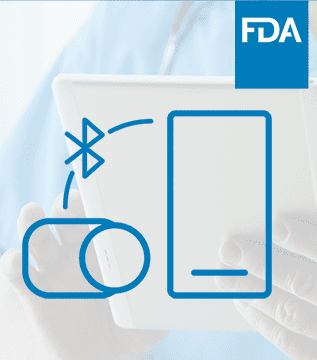
Article
Roundup: Bluetooth Medical Devices Cleared by FDA in 2024
We don’t have a crystal ball that can tell us what’s going to happen in MedTech in 2023. What we do have is industry veteran Steve Silverman, President of The Silverman Group, a consultancy that serves medical product companies on regulatory, strategy, and policy issues.
In Part 2 of this two-part guest blog, Steve offers his forecast for the MedTech industry in 2023. What changes are coming to the CDC, the FDA and regulatory standards for Software as a Medical Device (SaMD) and connected medical devices? To see how accurate Steve’s predictions from last year were, check out Part 1 here.
___________________________________________________________________________
As Hollywood has taught us, every sequel is better than the original. Need proof? Look no further than Police Academy 2, The Exorcist II, and Teen Wolf Too. Classics. So what better way to ring in 2023 than to examine how my 2022 predictions held up? To keep the fun going, I also made some predictions for what may happen at the US Food and Drug Administration in 2023. We’ll see if my educated guesses get more accurate.
Looking at my 2022 results, I’m rethinking my plan to become a fortune teller. I’ll try to do better for 2023.
This is not to suggest that COVID is actually gone. We’re simply rebranding it as an endemic, whatever that means. Calling COVID a public health emergency doesn’t make sense because it’s here to stay.
Ending the health emergency is big news for device makers selling products via emergency use authorizations or FDA enforcement discretion. These products will now only be allowed to stay on the market if they’re cleared through standard device review pathways, such as PMAs and 510(k)s.
That transition will begin this year but, as the FDA has promised, there will be ample transition time. Also, device-review will be streamlined with pandemic learnings – think less clinical evidence and more real-world evidence.
As a bonus, CDRH will finish its return to normal operations. Premarket review and postmarket enforcement will look like they did pre-pandemic and companies will again get to meet with CDRH staff. But this is the new “normal.” No one is fully shelving pandemic practices; some efficiencies and new regulatory requirements will remain. For proof, see the Omnibus spending bill, which authorizes FDA to require device shortage reports during public health emergencies.
Announcing that CDRH will go big on digital ranks with “wow, mountains are tall” on the list of deep insights.
But some changes are noteworthy. First, CDRH will counter staffing headwinds in digital oversight. Staff shortages have constrained all of CDRH, including its Digital Health Center of Excellence. The Digital Health Center needs more people and a permanent director, both of which will be priorities next year.
CDRH also will grapple with limits to its authority. Those limits hamstrung CDRH’s software precertification pilot program because the center couldn’t create new market pathways for digital devices. Next year, CDRH will leverage its authority and deploy new strategies to promote digital innovation. For example, CDRH will back change control plans for digital devices. These plans allow device companies to make specific, pre-identified changes to digital devices without triggering premarket review requirements. CDRH can deploy this new approach with its current authority and engage Congress to fill any gaps.
There’s no question, real-world evidence (RWE) is here to stay. RWE reaches all FDA-regulated medical products (i.e., drugs and biologics, as well as devices); FDA and industry back RWE; and it’s increasingly serving as an adjunct to (and eventually maybe a replacement for) traditional clinical studies.
Some quick background: RWE comes from data sources like electronic health records, claims and billing data, and disease registries. Sometimes, these sources can support product-review decisions like premarket applications and applications for expanded use. But there are obstacles. For example, RWE can be incomplete or difficult to integrate with data from other sources.
Still, CDRH is a strong RWE proponent. The center recently published a report detailing multiple RWE examples backing PMAs, 510(k)s, and other device premarket submissions. Look this year for CDRH and the rest of FDA to further embed RWE as a data source to evaluate medical products.
CDRH successfully promotes device innovation, and the Breakthrough Devices Program is a prime example.
The program supports devices that diagnose and treat life‑threatening and debilitating diseases, while preserving basic requirements like device premarket review, good manufacturing practice, and adverse event reporting. Breakthrough devices get a lot more attention from CDRH staff, meaning more premarket meetings, expedited action, and senior-staff engagement. But there are no guaranteed results. Breakthrough designation doesn’t mean that a device has a better chance of clearance or approval than devices outside the program.
Still, the numbers tell a success story. In 2015, there were about 10 devices in the breakthrough program. Last year, there were more than 160. Breakthrough designations will stay high this year, but whether that translates to better approval and clearance rates remains clouded. We already know that overall review doesn’t happen faster under the breakthrough program. With more data showing more results, we’ll have a better picture of whether program participants have improved odds of clearance and approval.
As important, growing breakthrough numbers will increase pressure on CDRH staff. The breakthrough program is resource-intensive. More meetings, expedited reviews, and similar measures require staff to do more work faster. Staff is already tired and spread thin after years of pandemic emergencies. Adding the demands of the breakthrough program will prolong staff’s return to normal operations.
I overuse the term “dumpster fire,” but I can’t think of a better description for in vitro diagnostic (IVD) regulation.
To recap, CDRH IVD oversight has been in limbo for years. Finally, the planets align with a compromise affirming CDRH’s authority while treating IVDs differently from standard devices. The FDA is on board and industry is on board, so we’ve got a deal, right?
Wrong. First, VALID, the law fixing IVDs, fell off MDUFA V along with every other legislative rider. But no problem – Congress has to authorize the 2023 budget, offering another bite at the apple. Now, budget authorization is done and VALID is nowhere to be seen. But that makes sense. The budget runs past 4,000 pages, so I guess Congress just didn’t have enough room.
FDA Commissioner Califf has promised to use rulemaking to deliver what Congress didn’t. This begs the question why Congress was needed if the FDA could just fix this problem on its own. It’s hard to see regulation having any chance of success. Apart from its glacial pace, there’s the near‑certain lawsuits from opponents of FDA measures. I hope to have grandchildren one day, and I’m excited to celebrate with them the arrival of IVD regulation.
I wish all of you reading this a very happy 2023. With luck, by next January, you’ll have forgotten my predictions and I’ll then claim total success.
___________________________________________________________________________
This is Part 2 of a two-part guest blog from Steve Silverman. Navigate to the other blogs in this series with the links below:
Related Posts

Article
Roundup: Bluetooth Medical Devices Cleared by FDA in 2024

Article
Help Us Build an Authoritative List of SaMD Cleared by the FDA

Article
SaMD Cleared by the FDA: The Ultimate Running List

Article
Roundup: Bluetooth Medical Devices Cleared by FDA in 2023